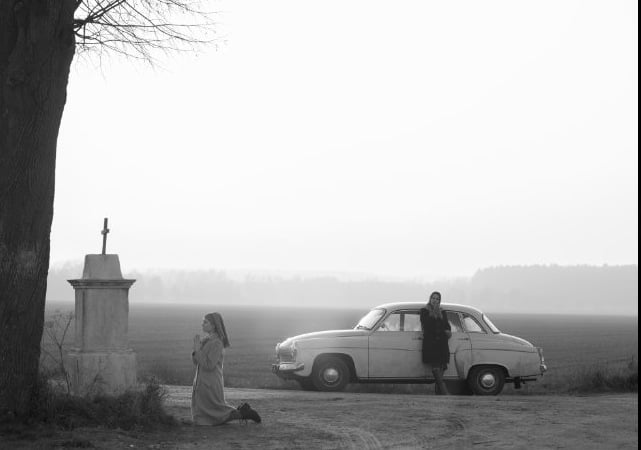

Screened at the 40th Seattle International Film Festival, Pawel Pawlikowski’s atmospheric “Ida” opened June 13, 2014 at the SIFF Cinema Uptown in Seattle. Presented in 35mm format, this film is one of the most visually striking black and white productions to be seen. Director Pawlikowski (“Last Resort,” “My Summer of Love”) works closely with Agata Kulesza and Agata Trzebuchowska to present this moving and intimate story.
The story begins with Anna (Agata Trzebuchowska), an 18-year-old novitiate in a convent in Poland in 1962. On the verge of taking her vows, Anna is informed by the mother superior that there one task that she must complete before she can become a sister of the convent. Anna must go to her aunt Wanda (Agata Kulesza) and reconcile Wanda’s life with her own life, their mutual history and history of their family in Nazi-occupied Poland.
Meeting her aunt, the audience is told the back story leading up to this fateful joining. As an infant, the Jewish girl with the name of Ida was left in the care of a priest in a small hamlet in rural Poland. There is no knowledge of the rest of Ida’s (Anna’s) family. Anna’s aunt Wanda survived the war because she had left the rest of the family, including her young son, to fight with the resistance. When she returned, they were all gone and her life has been a slow death of promiscuity and drunkenness ever since. Although she continues to prosecute war criminals on behalf of the victims of the holocaust, her own history, specifically her perceived abandonment of her son, is proving too much for her.
Reunited with Anna, her only remaining kin, the two set off to learn the fate of their families and, if possible, to recover their remains and do what little is possible to bring closure to that horrific chapter in their lives.
There are other films in circulation with similar story lines. Although a fearsomely close kept secret for many years, it is now generally accepted that local Polish citizens played a direct role in murdering Jews hiding from the SS. Director/screenwriter Pawlikowski understands this and does not assign blame as much as he opens a festering wound to the only possible recovery, the light of day. Meeting first with what appears to be a stone wall of silence in the local community; the two learn the truth about the last minutes of their loved ones’ lives and, at the same time, learn about themselves.
Anna is forced to make a crucial decision about her life, just as we, the viewers, are forced to make a crucial decision about the nature and assignment of blame. It is the genius of the film maker that this decision is made as painfully complex as it is painfully obvious. Pawlikowski refuses to give us the easy way out, forcing us to step into the shoes of each of the film’s disparate characters. In the end, we are relieved at not having to have made the decisions forced on others. As for assigning blame, this story provides no fodder for the hateful mind. We are confronted with the responsibility to understand, beyond that few of us will have much hate left.

Although Agata Trzebuchowska has the titular role, it is Agata Kulesza as aunt Wanda who does the heavy lifting in this film. She is saddled with a wide range of guilt, anger and hopelessness and must act out all of these emotions in every scene. Although Anna’s life has been affected most by the holocaust, Wanda is the one who has been forced to live those traumatic times over and over, every day. She is the true hero of the film and like most wartime heroes, she receives no honor or compensation that comes close to matching the damage done to her.
Anna is also forced to make a decision. By the end of the film she has grown more in a week than in her previous eighteen years in the convent. A huge world has unfolded in front of her, a world with all of the love, hate, joy and despair that any one person would be likely to know. Her life in the convent could never be the same after what she has learned. In Wanda’s apartment a strange transformation occurs that Anna will never forget.
At its worst, a bleak film shot in piercingly brutal black and white. At its best, another piece of the puzzle in understanding the causes and effects of things that must never be allowed to happen again.